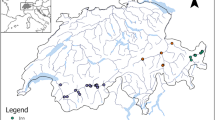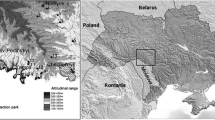Abstract
Changes in plant species richness across environmental and temporal gradients have often been explained by the intermediate disturbance hypothesis and a unimodal diversity–productivity relationship. We tested these predictions using two sets of mountain plant communities assembled along postglacial successional and snow depth (disturbance and stress) gradients in maritime Kamchatka. In each community, we counted the number of species in plots of increasing sizes (0.0025–100 m2) and analyzed them using species–area curves fitted by the Arrhenius power function and the Gleason logarithmic function. A comparison of successional communities along a 270-year-old moraine chronosequence behind the receding Koryto Glacier—representing gradients of increasing productivity and resource competition—confirmed the unimodal species richness pattern. The plant diversity peaked in a 60–80-year-old Salix–Alnus stand where light availability was sufficient to sustain a rich understory combining pioneer and late successional herbs. The closed Alnus canopy on older moraines caused a pronounced decrease in species richness for all plot sizes (interactive stage 80–120 years since deglaciation). A slight increase in species richness in the oldest assortative stages (120–270 years), when Alnus stands are mature, was found only at the smaller spatial scales. This reflects (i) the consolidation of clonal understory dominants and (ii) the absence of other woody species such as Betula ermanii whose invasion would eliminate Alnus and increase diversity at larger spatial scales. A comparative study of major mountain plant communities distributed above the Koryto Glacier foreland did not confirm the highest species richness at intermediate levels of disturbance and stress. Contrary to our expectation, the species richness was highest in alpine tundra and snowbed communities, which are subjected to severe winter frost and a short summer season, while less disturbed communities of subalpine meadows, heaths, and Betula ermanii woods were less species-rich. We attribute this pattern to differences in habitat area and species pool size.




Similar content being viewed by others
References
Arrhenius O (1921) Species and area. J Ecol 9:95–99
Braitseva OA, Ponomareva VV, Sulerzhitsky LD, Melekestsev IV, Bailey J (1997) Holocene key-marker tephra layers in Kamchatka, Russia. Quat Res 47:125–139
Burga CA, Krüsi B, Egli M, Wernli M, Elsener S, Ziefle M, Fischer T, Mavris C (2010) Plant succession and soil development on the foreland of the Morteratsch glacier (Pontresina, Switzerland): straight forward or chaotic? Flora 205:561–576
Darwin C (1859) On the origin of species by means of natural selection, or the preservation of favoured races in the struggle for life. John Murray, London
Doležal J, Homma K, Vyatkina MP, Yakubov V, Vetrova VP, Hara T (2008) Primary succession following deglaciation at Koryto Glacier Valley, Kamchatka. Arct Antarct Alp Res 40:309–322
Doležal J, Ishii H, Kyncl T, Takahashi K, Vetrova VP, Homma K, Sumida A, Hara T (2010) Climatic factors affecting radial growth of Betula ermanii and B. platypylla in Kamchatka. Can J For Res 40:273–285
Doležal J, Altman J, Kopecký M, Černý T, Janeček S, Petřík P, Bartoš M, Šrůtek M, Lepš J, Song JS (2012) Plant diversity changes during the postglacial in East Asia: insights from forest refugia on Halla Volcano, Jeju Island. PLoS One 7:e33065
Dvorský M, Doležal J, de Bello F, Klimešová J, Klimeš L (2011) Vegetation of East Ladakh: species and growth form composition along environmental gradients. Appl Veg Sci 14:132–147
Fastie CL (1995) Causes and ecosystem consequences of multiple pathways of primary succession at Glacier Bay, Alaska. Ecology 76:1899–1916
Favero-Longo SE, Worland MR, Convey P, Lewis Smith RI, Piervittori R, Guglielmin M, Cannone N (2012) Primary succession of lichen and bryophyte communities following glacial recession on Signy Island, South Orkney Islands, Maritime Antarctic. Antarct Sci 24:323–326
Garibotti IA, Pissolito CI, Villalba R (2011) Spatiotemporal pattern of primary succession in relation to meso-topographic gradients on recently deglaciated terrains in the Patagonian Andes. Arct Antarct Alp Res 43:555–567
Gleason HA (1922) On the relation between species and area. Ecology 3:158–162
Jones CC, del Moral R (2005) Patterns of primary succession on the foreland of Coleman Glacier, Washington, USA. Plant Ecol 180:105–116
Karger DN, Kluge J, Krömer T, Hemp A, Lehnert M, Kessler M (2011) The effect of area on local and regional elevational patterns of species richness. J Biogeogr 38:1177–1185
Khomentovsky PA (1998) Pinus pumila (Siberian Dwarf Pine) on the Kamchatka Peninsula, Northeast Asia. In: Laderman AD (ed) Coastally restricted forest. Oxford University Press, Oxford, pp 199–220
Komárková V, Wielgolaski FE (1999) Stress and disturbance in cold regions. In: Walker LR (ed) Ecosystem of disturbed ground. Elsevier Science & Technology Books, Amsterdam
Körner C (2003) Alpine plant life. Springer, Berlin
Krestov PV (2003) Forest vegetation of the easternmost Russia (Russian Far East). In: Kolbek J, Šrůtek M, Box E (eds) Forest vegetation of Northeast Asia. Kluwer, Dordrecht, pp 93–180
Kuvaev VB (1993) The altitudinal distribution of vascular plants in the mountains of the Kronotsky Reservation (eastern Kamchatka). Botanicheskii Zhurnal (St. Petersburg) 78:25–48
Lepš J (2005) Diversity and ecosystem function. In: van der Maarel E (ed) Vegetation ecology. Blackwell Science, Oxford, pp 199–237
Lichter J (1998) Primary succession and forest development on coastal Lake Michigan sand dunes. Ecol Monogr 68:487–510
Magurran AE (2004) Measuring biological diversity. Blackwell, Malden
Matthews JA (1992) The ecology of recently deglaciated terrain. A geoecological approach to glacier forelands and primary succession. Cambridge University Press, Cambridge
Muravyev YD (1999) Present-day glaciation in Kamchatka: distribution of glaciers and snow. In: Naruse R (ed) Cryospheric studies in Kamchatka II. The Institute of Low Temperature Science, Hokkaido University, Sapporo, pp 1–7
Muravyev YD, Ovsyannikov AA, Shiraiwa T (2007) Activity of the northern volcano group according to drilling data in the Ushkovsky crater glacier, Kamchatka. J Volcanol Seismol 1:42–52
Oksanen J (1996) Is the humped relationship between species richness and biomass an artefact due to plot size? J Ecol 84:293–295
Oliver CD, Adams AB, Zasoski RJ (1985) Disturbance patterns and forest development in a recently deglaciated valley in the northwestern Cascade Range of Washington, USA. Can J For Res 15:221–232
Palmer MW (2007) Species–area curves and the geometry of nature. In: Storch D, Marquet PA, Brown JH (eds) Scaling biodiversity. Cambridge University Press, Cambridge, pp 15–31
Qian H, White PS, Song J-S (2007) Effects of regional vs ecological factors on plant species richness: an intercontinental analysis. Ecology 88:1440–1453
Raffl C, Mallaun M, Mayer R, Erschbamer B (2006) Vegetation succession pattern and diversity changes in a glacier valley, central Alps, Austria. Arct Antarct Alp Res 38:421–428
Rahbek C (2005) The role of spatial scale and the perception of large-scale species-richness patterns. Ecol Lett 8:224–239
Rejmánek M, Rejmánková E (2002) Biogeography of artificial islands: effects of age, area, elevation, and isolation on plant species richness. Preslia 74:307–314
Rejmánek M, Rejmánková E, Holzner W (2004) Species diversity of plant communities on calcareous screes: the role of intermediate disturbance. Preslia 76:207–222
Robbins JA, Matthews JA (2010) Regional variation in successional trajectories and rates of vegetation change on glacier forelands in south-central Norway. Arct Antarct Alp Res 42:351–361
Romdal TS, Grytnes JA (2007) An indirect area effect on elevational species richness patterns. Ecography 30:440–448
Roxburgh SH, Shea K, Wilson JB (2004) The intermediate disturbance hypothesis: patch dynamics and mechanisms of species coexistence. Ecology 85:359–371
Shamshin VA (1999) The stone birch forests of Kamchatka: biology, ecology and stand structure. GEOS, Moscow (in Russian)
Shiraiwa T, Muravyev YD, Yamaguchi S, Glazirin GE, Kodama Y, Matsumoto T (1997) Glaciological features of Koryto Glacier in the Kronotsky Peninsula, Kamchatka, Russia. Bull Glaciol Res 15:27–36
Solomina O, Calkin PE (2003) Lichenometry as applied to moraines in Alaska, USA, and Kamchatka, Russia. Arct Antarct Alp Res 35:129–143
Solomina O, Wiles G, Shiraiwa T, D’Arrigo R (2007) Multiproxy records of climate variability for Kamchatka for the past 400 years. Clim Past 3:119–128
Stohlgren TJ (2007) Measuring plant diversity: lessons from the field. Oxford University Press, Oxford
Strauss SL, Ruhland CT, Day TA (2009) Trends in soil characteristics along a recently deglaciated foreland on Anvers Island, Antarctic Peninsula. Polar Biol 32:1779–1788
R Development Core Team (2010) R: a language and environment for statistical computing. ISBN 3-900051-07-0. http://www.R-project.org. Accessed 1 Feb 2012
Walker LR, del Moral R (2003) Primary succession and ecosystem rehabilitation. Cambridge University Press, Cambridge
Warton DI, Duursma RA, Falster DS, Taskinen S (2012) smatr 3—an R package for estimation and inference about allometric lines. Meth Ecol Evol 3:257–259
Wilson EO (1969) The species equilibrium. In: Woodwell G. M. & Smith H. H. (eds), Diversity and stability in ecological systems. Brookhaven Symp Biol 22: 38–47
Yakubov VV (1997) Vascular plants of the Kronotsky Biosphere Reserve (Kamchatka). Vladivostok
Acknowledgments
The authors thank Marina Vyatkina, K. Homma, K. Takahashi, A. Ovsanikov, K. Yamagata, and T. Sone for their field assistance and Valentina Vetrova and the members of the Kamchatka Institute of Ecology and Nature Management in Petropavlovsk-Kamchatsky, for their hospitality and logistic support. This study was supported by a Monbusho Grant-in-Aid for International Scientific Research (11691166), Japan. JD was supported by GAČR 13-13368S and GAJU 138/2010/P. The authors thank Dr. Brian G. McMillan for linguistic improvements.
Author information
Authors and Affiliations
Corresponding author
Electronic supplementary material
Below is the link to the electronic supplementary material.
11258_2013_184_MOESM2_ESM.doc
Supplementary Fig. S1 Layout of the 10 × 10 m plots with two sequences of nested square subplots with increasing size of 0.0025–0.01–0.0625–0.25–1–6.25–25–100 m2 sampled for assessing species–area curves. The numbers refer to the lengths of the edges of the respective squares in metres. (DOC 31 kb)
Rights and permissions
About this article
Cite this article
Doležal, J., Yakubov, V. & Hara, T. Plant diversity changes and succession along resource availability and disturbance gradients in Kamchatka. Plant Ecol 214, 477–488 (2013). https://doi.org/10.1007/s11258-013-0184-z
Received:
Accepted:
Published:
Issue Date:
DOI: https://doi.org/10.1007/s11258-013-0184-z




